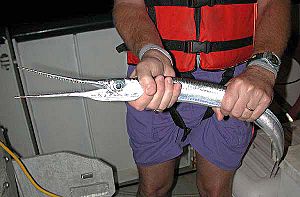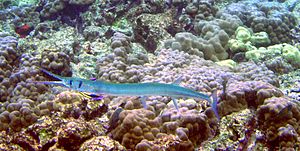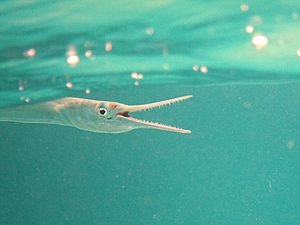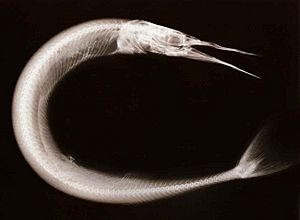Needlefish facts for kids
Quick facts for kids Needlefish |
|
|---|---|
 |
|
| Tylosurus crocodilus | |
| Scientific classification |
|
| Kingdom: | Animalia |
| Phylum: | Chordata |
| Class: | Actinopterygii |
| Order: | Beloniformes |
| Superfamily: | Scomberesocoidea |
| Family: | Belonidae Bonaparte, 1832 |
| Genera | |
|
Ablennes |
|
Needlefish (also called long toms) are a family of fish known as Belonidae. These fish mostly live in very shallow ocean waters or near the surface of the open sea. They are carnivores, meaning they eat other fish.
Some types of needlefish live in the ocean, in brackish water (a mix of fresh and salt water), and even in freshwater rivers. Other types only live in freshwater. Needlefish look a lot like North American freshwater gars. They are long and thin, with long, narrow jaws full of sharp teeth. Even though they look similar, needlefish and gars are not closely related. The name "garfish" was first used for a type of needlefish in Europe. Later, it was used for the North American fish by European settlers.
Contents
What Needlefish Look Like
Needlefish are slender fish. They can be from about 3 centimeters (1.2 inches) to 95 centimeters (37 inches) long. They have one dorsal fin (on their back) placed far back on their body. It is almost directly across from their anal fin (on their underside).
Their most special feature is their long, narrow beak. This beak has many sharp teeth. When needlefish are young, their upper jaw is shorter than their lower jaw. This makes them look like they have a "half-beak." At this stage, they eat tiny sea creatures called plankton. As they grow, their upper jaw gets longer. Once their beak is fully grown, they start eating other fish.
Reproduction and Life Cycle
Needlefish reproduce by mating and laying eggs. The male fish often rides on the female fish as they mate in the waves.
Needlefish are most common in warm, subtropical areas. However, some types also live in cooler waters, especially during winter. For example, the Belone belone is a common type found in the North Atlantic. These fish often swim in groups alongside tuna. Recently, some small needlefish have been seen in the Mediterranean Sea.
How Needlefish Hunt
All needlefish mainly eat smaller fish. Some types also eat krill, swimming crustaceans (like shrimp), and small cephalopods (like squid). Saltwater needlefish are also hunters. For example, the Indian species eats only large crustaceans.
Needlefish are very clever hunters. They use a trick called "Snell's Window" when they attack prey. Imagine looking up from underwater. You see a bright circle of light above you; that's Snell's Window. Objects outside this window look bent or distorted because of how light bends through water (light refraction). Needlefish leap out of the water at a low angle. When they do this, their shape looks distorted to the fish they are hunting. This helps the needlefish get very close to their prey without being seen.
Are Needlefish Dangerous to Humans?

Needlefish can jump out of the water very fast, up to 60 kilometers per hour (37 miles per hour). Since they swim near the surface, they sometimes leap over the decks of small boats instead of swimming around them.
This jumping happens more often at night, especially when there are bright artificial lights. Night fishermen and divers in the Pacific Ocean have reported groups of needlefish suddenly jumping towards light sources at high speed. Their sharp beaks can cause deep puncture wounds. Sometimes, parts of their beak can break off inside the person. For many people living on Pacific Islander islands who fish near reefs from small boats, needlefish can be a greater risk than sharks.
There have been reports of serious injuries and even deaths caused by needlefish. For example, in 2010, a kayaker in Florida was hurt when a needlefish jumped and hit her chest. In 2018, a Thai Navy cadet died after being hit by a needlefish. These incidents show that while rare, needlefish can be dangerous due to their speed and sharp beaks.
Needlefish as Pets
Some types of needlefish live in brackish and freshwater. One freshwater species, Xenentodon cancila from Southeast Asia, is sometimes kept in aquariums. This species is relatively small, growing up to 40 centimeters (16 inches) long. However, they are considered delicate fish. This means they are best for experienced aquarists (people who keep fish tanks).
Needlefish in the Fish Family Tree
Needlefish belong to a larger group of fish called Beloniformes. They are related to sauries. Scientists study how these fish families are connected to understand their evolution.
Images for kids
See also
 In Spanish: Agujones para niños
In Spanish: Agujones para niños




